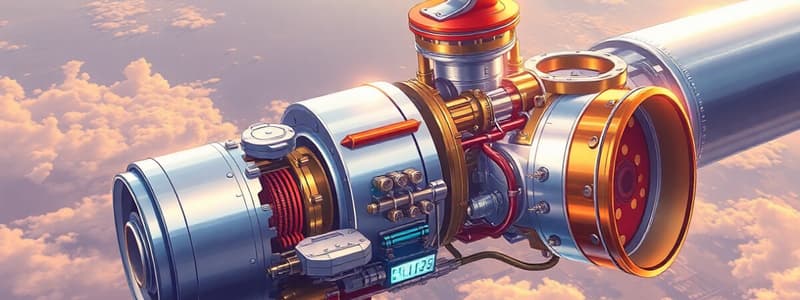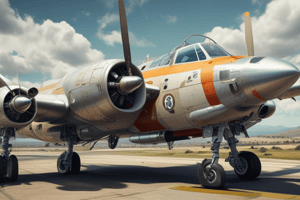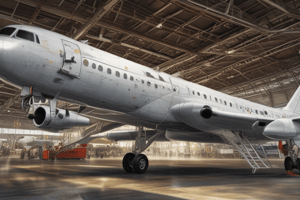Podcast
Questions and Answers
What is the normal operating pressure for the hydraulic systems in the aircraft?
What is the normal operating pressure for the hydraulic systems in the aircraft?
- 1,500 PSI
- 3,000 PSI (correct)
- 2,500 PSI
- 4,000 PSI
How many independent hydraulic systems are present in the aircraft?
How many independent hydraulic systems are present in the aircraft?
- Four
- Two
- Three (correct)
- One
What is a unique feature of the hydraulic systems in the aircraft?
What is a unique feature of the hydraulic systems in the aircraft?
- They can transfer fluid between each other.
- They operate only when the engine is running.
- They are supplied from a central reservoir.
- Each system is supplied from its own hydraulic reservoir. (correct)
What does the Hydraulic System Monitoring Unit (HSMU) do?
What does the Hydraulic System Monitoring Unit (HSMU) do?
What is the operating pressure of the hydraulic system during RAT deployment?
What is the operating pressure of the hydraulic system during RAT deployment?
What happens when one engine fails during flight?
What happens when one engine fails during flight?
Which component pressurizes the green system during an emergency?
Which component pressurizes the green system during an emergency?
What is the effect on the aileron, elevator, and spoiler servo control speeds when the RAT is in operation?
What is the effect on the aileron, elevator, and spoiler servo control speeds when the RAT is in operation?
What occurs in the green system during the landing gear lever selection up after an engine failure?
What occurs in the green system during the landing gear lever selection up after an engine failure?
What happens to the BLUE ELEC PUMP in the event of an Engine 1 failure in addition to a prim 1 and 3 loss ? 330. - 300
What happens to the BLUE ELEC PUMP in the event of an Engine 1 failure in addition to a prim 1 and 3 loss ? 330. - 300
Which component can pressurize the blue system besides Engine 1?
Which component can pressurize the blue system besides Engine 1?
What condition triggers the electric pump to run automatically in flight?
What condition triggers the electric pump to run automatically in flight?
Why should the electric pump not replace engine-driven pumps for pressurizing the yellow system?
Why should the electric pump not replace engine-driven pumps for pressurizing the yellow system?
How can crewmembers operate the cargo doors when there is no electrical power available?
How can crewmembers operate the cargo doors when there is no electrical power available?
When does the electric pump operate on the ground?
When does the electric pump operate on the ground?
When can the RAT be stowed?
When can the RAT be stowed?
What triggers the automatic deployment of the RAT?
What triggers the automatic deployment of the RAT?
How can the RAT be manually deployed?
How can the RAT be manually deployed?
What is the purpose of the RAT in the hydraulic system?
What is the purpose of the RAT in the hydraulic system?
What occurs when both the green and yellow or green and blue reservoirs have a low level?
What occurs when both the green and yellow or green and blue reservoirs have a low level?
What is the range of RAT flow as a percentage of an engine-driven pump's flow capability?
What is the range of RAT flow as a percentage of an engine-driven pump's flow capability?
Which factor influences the RAT flow capability in aircraft?
Which factor influences the RAT flow capability in aircraft?
What action does the flight crew take to close the green hydraulic fire shut-off valves?
What action does the flight crew take to close the green hydraulic fire shut-off valves?
What occurs automatically after 150 seconds if the blue and yellow reservoir levels are normal when the green fluid goes down ? 330-300
What occurs automatically after 150 seconds if the blue and yellow reservoir levels are normal when the green fluid goes down ? 330-300
Under what condition do the green fire shut-off valves remain closed after a green hydraulic low level ?
Under what condition do the green fire shut-off valves remain closed after a green hydraulic low level ?
What limitation is placed on the flight crew regarding the fire shut-off valves once they are closed?
What limitation is placed on the flight crew regarding the fire shut-off valves once they are closed?
What is the triggering condition for the automatic closure of the engine green hydraulic fire shut-off valves?
What is the triggering condition for the automatic closure of the engine green hydraulic fire shut-off valves?
What is the primary source of pressure for the hydraulic reservoirs?
What is the primary source of pressure for the hydraulic reservoirs?
What happens if the bleed air pressure from Engine 1 is insufficient?
What happens if the bleed air pressure from Engine 1 is insufficient?
What is the purpose of maintaining a high enough pressure in the hydraulic system?
What is the purpose of maintaining a high enough pressure in the hydraulic system?
What is the primary purpose of the leak measurement valves in hydraulic systems?
What is the primary purpose of the leak measurement valves in hydraulic systems?
What happens to the yellow leak measurement valve during cargo door operation?
What happens to the yellow leak measurement valve during cargo door operation?
During low hydraulic pressure, what does the priority valve prioritize?
During low hydraulic pressure, what does the priority valve prioritize?
What role does the Hydraulic System Monitoring Unit (HSMU) play during flight?
What role does the Hydraulic System Monitoring Unit (HSMU) play during flight?
What color indicates the nominal filling range when fluid temperature information is available?
What color indicates the nominal filling range when fluid temperature information is available?
What happens to the indication when the fluid level goes below the warning level?
What happens to the indication when the fluid level goes below the warning level?
What color does the indication become when temperature information is unavailable?
What color does the indication become when temperature information is unavailable?
When the fluid temperature effect is corrected, which of the following best describes the indication color?
When the fluid temperature effect is corrected, which of the following best describes the indication color?
Which color indicates that pressure is increasing within the hydraulic system?
Which color indicates that pressure is increasing within the hydraulic system?
What is the maximum pressure before the system indicates decreasing pressure?
What is the maximum pressure before the system indicates decreasing pressure?
What color changes to indicate low pressure levels in the system?
What color changes to indicate low pressure levels in the system?
Flashcards
Hydraulic System
Hydraulic System
The primary means of providing hydraulic power to the aircraft. Operates independently and is not interconnected with other hydraulic systems.
Hydraulic System Color
Hydraulic System Color
Hydraulic systems are named after the color of their fluid, but in reality, this color identifies the system.
Hydraulic System Monitoring Unit (HSMU)
Hydraulic System Monitoring Unit (HSMU)
The device that monitors each hydraulic system's pressure and other conditions.
Ram Air Turbine (RAT)
Ram Air Turbine (RAT)
Signup and view all the flashcards
Hydraulic Reservoir
Hydraulic Reservoir
Signup and view all the flashcards
Green System
Green System
Signup and view all the flashcards
Electric Pump
Electric Pump
Signup and view all the flashcards
25 second automatic run
25 second automatic run
Signup and view all the flashcards
Reduced servo control speeds
Reduced servo control speeds
Signup and view all the flashcards
Blue Hydraulic System
Blue Hydraulic System
Signup and view all the flashcards
Electrical Rudder
Electrical Rudder
Signup and view all the flashcards
BLUE ELEC PUMP
BLUE ELEC PUMP
Signup and view all the flashcards
Asymmetric Thrust
Asymmetric Thrust
Signup and view all the flashcards
Yaw Sideslip
Yaw Sideslip
Signup and view all the flashcards
Yellow Hydraulic System
Yellow Hydraulic System
Signup and view all the flashcards
Yellow Electric Pump
Yellow Electric Pump
Signup and view all the flashcards
Hand Pump (Yellow System)
Hand Pump (Yellow System)
Signup and view all the flashcards
Electric Pump Flow (Yellow System)
Electric Pump Flow (Yellow System)
Signup and view all the flashcards
Electric Pump Limitations (Yellow System)
Electric Pump Limitations (Yellow System)
Signup and view all the flashcards
RAT Deployment
RAT Deployment
Signup and view all the flashcards
RAT Stowing
RAT Stowing
Signup and view all the flashcards
RAT Auto-Deployment
RAT Auto-Deployment
Signup and view all the flashcards
Manual RAT Extension
Manual RAT Extension
Signup and view all the flashcards
What is the RAT's purpose?
What is the RAT's purpose?
Signup and view all the flashcards
How does the RAT flow rate vary?
How does the RAT flow rate vary?
Signup and view all the flashcards
What influences the RAT flow rate?
What influences the RAT flow rate?
Signup and view all the flashcards
How does the RAT's pressure compare to the main system?
How does the RAT's pressure compare to the main system?
Signup and view all the flashcards
Why is the RAT important?
Why is the RAT important?
Signup and view all the flashcards
Fire Shut-Off Valve (Green System)
Fire Shut-Off Valve (Green System)
Signup and view all the flashcards
Green System Fire Shut-Off Valve Reopening
Green System Fire Shut-Off Valve Reopening
Signup and view all the flashcards
Green System Fire Shut-Off Valve Closure in Case of Blue/Yellow Reservoir Low Level
Green System Fire Shut-Off Valve Closure in Case of Blue/Yellow Reservoir Low Level
Signup and view all the flashcards
Fire Shut-Off Valve Manual Reopening
Fire Shut-Off Valve Manual Reopening
Signup and view all the flashcards
HSMU Role in Green Fire Shut-Off Valve Activation
HSMU Role in Green Fire Shut-Off Valve Activation
Signup and view all the flashcards
Hydraulic System Bleed Air Source
Hydraulic System Bleed Air Source
Signup and view all the flashcards
Cavitation Prevention in Hydraulic Systems
Cavitation Prevention in Hydraulic Systems
Signup and view all the flashcards
Automatic Bleed Air Source Switching
Automatic Bleed Air Source Switching
Signup and view all the flashcards
Importance of Pressure in Hydraulic Systems
Importance of Pressure in Hydraulic Systems
Signup and view all the flashcards
Crossbleed Duct Function in Hydraulic Systems
Crossbleed Duct Function in Hydraulic Systems
Signup and view all the flashcards
What are Leak Measurement Valves?
What are Leak Measurement Valves?
Signup and view all the flashcards
What does the Priority Function do?
What does the Priority Function do?
Signup and view all the flashcards
How does the HSMU impact Leak Measurement Valves?
How does the HSMU impact Leak Measurement Valves?
Signup and view all the flashcards
What is the function of the Yellow Hydraulic System?
What is the function of the Yellow Hydraulic System?
Signup and view all the flashcards
What are the electric pump limitations for the Yellow Hydraulic System?
What are the electric pump limitations for the Yellow Hydraulic System?
Signup and view all the flashcards
Hydraulic Fluid Level Warning
Hydraulic Fluid Level Warning
Signup and view all the flashcards
Hydraulic System Indicator and Temperature
Hydraulic System Indicator and Temperature
Signup and view all the flashcards
Green Hydraulic System Function
Green Hydraulic System Function
Signup and view all the flashcards
Yellow Hydraulic System Function
Yellow Hydraulic System Function
Signup and view all the flashcards
Yellow Hydraulic System Electric Pump
Yellow Hydraulic System Electric Pump
Signup and view all the flashcards
Fire Shut-Off Valve
Fire Shut-Off Valve
Signup and view all the flashcards
Study Notes
Aircraft Hydraulic Systems
-
Aircraft has three independent hydraulic systems (GREEN, BLUE, YELLOW).
-
Each system uses its own hydraulic reservoir.
-
Normal operating pressure is 3,000 PSI (2,500 PSI for RAT).
-
Hydraulic fluid cannot be transferred between systems.
-
Systems monitored by a Hydraulic System Monitoring Unit (HSMU).
-
Fire Shut-off Valves: A fire shutoff valve is positioned upstream of each engine-driven pump. The flight crew can close the valve by pushing the FIRE pushbutton. Both engine green hydraulic fire shut-off valves are automatically closed by the HSMU in the event of a green reservoir low level.
- 150 seconds after initial closure, if blue and yellow reservoir levels are normal, the green engine-driven pumps are automatically depressurized and the fire shut-off valves are reopened, to lubricate and avoid damage to the engine-driven pumps.
- If a further blue or yellow reservoir low level occurs, the green fire shut-off valves remain closed, enabling the green system to be restored by using the RAT.
- Flight crew cannot reopen the fire shut-off valves in flight once they've been automatically closed.
-
Green system: pressurized by two engine-driven pumps.
-
Green system is also pressurized by an electric pump, manually or automatically controlled.
- In flight, if an engine fails, the electric pump automatically runs for 25 seconds when the landing gear lever is selected up (to ensure gear retraction).
- A Ram Air Turbine (RAT) driven pump pressurizes the green system during emergencies. A drop-out RAT, coupled to a hydraulic pump, allows the green system to function. The RAT can be extended manually by pressing the RAT MAN ON pushbutton.
- RAT pressurization reduces aileron, elevator, and spoiler servo control operating speeds. The RAT flow varies between 15% and 45% of an engine-driven pump flow capability, depending on the aircraft's speed.
- The RAT deploys automatically in the event of both engine failure or a low level in the green and yellow or green and blue reservoirs. It can be manually deployed from the overhead panel. It can only be stowed when the aircraft is on the ground.
-
Blue system: pressurized by an engine-driven pump (Engine 1).
-
Blue system is also pressurized by a manually-controlled electric pump.
- In the event of Engine 1 failure, and a PRIM 1 or PRIM 3 loss, the blue electric pump runs automatically in flight to maintain rudder authority, countering yaw sideslip from asymmetrical thrust.
-
Yellow system: pressurized by an engine-driven pump (Engine 2).
-
Yellow system is also pressurized by an electric pump, manually or automatically controlled.
- This allows for ground operations when engines are stopped.
- The electric pump runs automatically:
- In flight, in the event of Engine 2 failure, if the FLAPS lever is not at 0 (to ensure flap retraction in a proper time at takeoff).
- On the ground during cargo door operation.
- Crewmembers can use a hand pump to pressurize the yellow system for cargo door operation when no electrical power is available.
- Electric pump flow is approximately 18% of the engine-driven pump flow capacity.
- Electric pump is for surface retraction, not to replace engine-driven pumps.
Hydraulic Reservoir Pressurization
- Normally, high-pressure bleed air from engine 1 automatically pressurizes the hydraulic reservoirs.
- If the bleed air pressure is too low, the system takes bleed air pressure from the crossbleed duct.
- The system maintains a high enough pressure to prevent the hydraulic pumps from cavitating.
Leak Measurement Valves
- Leak measurement valves are positioned upstream of the primary flight controls.
- Leak measurement valves are used for leak measurement of each system.
- Leak measurement valves can only be closed on the ground, using the LEAK MEASUREMENT VALVES pushbutton on the panel.
- The yellow leak measurement valve is automatically closed during cargo door operation.
- The HSMU prevents the closure of green, blue, and yellow hydraulic leak measurement valves during flight.
Priority Function
- In case of low hydraulic pressure, a priority valve cuts off hydraulic power to heavy load users (emergency generator, nosewheel steering, landing gear) to maintain pressure for normal braking and flight controls.
- A Pressure-Off Brake system maintains the pressure on flaps, slats, and THS actuator.
- This ensures the normal function of crucial systems like braking and flight controls during low pressure conditions. The system maintains the same function in low hydraulic pressure conditions.
Studying That Suits You
Use AI to generate personalized quizzes and flashcards to suit your learning preferences.



